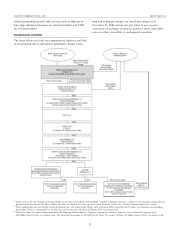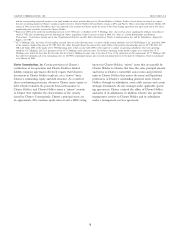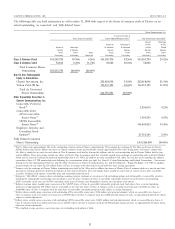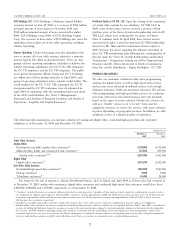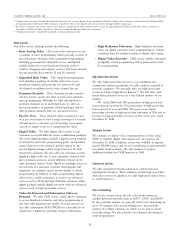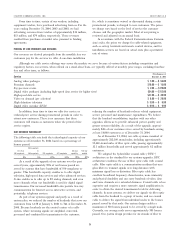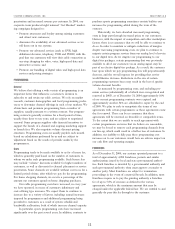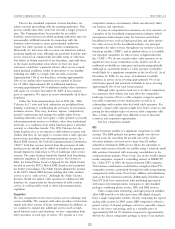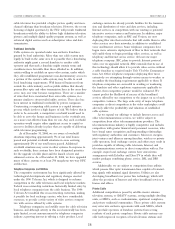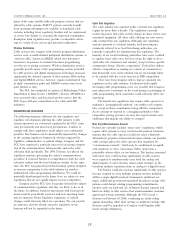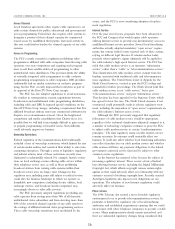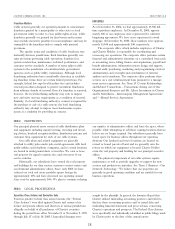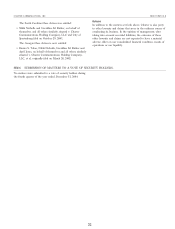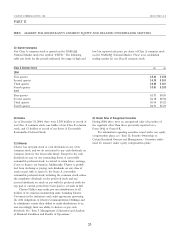Charter 2004 Annual Report Download - page 23
Download and view the complete annual report
Please find page 23 of the 2004 Charter annual report below. You can navigate through the pages in the report by either clicking on the pages listed below, or by using the keyword search tool below to find specific information within the annual report.
CHARTER COMMUNICATIONS, INC. 2004 FORM 10-K
In addition, while we continue to believe that the initial conventional telephone lines. DSL service therefore is competi-
investment by a DBS customer exceeds that of a cable customer, tive with high-speed Internet access over cable systems. Most
the initial equipment cost for DBS has decreased substantially, telephone companies which already have plant, an existing
as the DBS providers have aggressively marketed offers to new customer base, and other operational functions in place (such as,
customers of incentives for discounted or free equipment, billing, service personnel, etc.) offer DSL service. DSL actively
installation and multiple units. DBS providers are able to offer markets its service and many providers have offered promotional
service nationwide and are able to establish a national image pricing with a one-year service agreement. The FCC has
and branding with standardized offerings, which together with initiated a rulemaking proceeding that could materially reduce
their ability to avoid franchise fees of up to 5% of revenues and existing regulation of DSL service, essentially freeing such
property tax, leads to greater efficiencies and lower costs in the service from traditional telecommunications regulation. It is also
lower tiers of service. However, we believe that most consumers possible that federal legislation could reduce regulation of
continue to prefer our stronger local presence in our markets. Internet services offered by incumbent telephone companies.
We believe that cable-delivered VOD and SVOD service are Legislative action and the FCC’s decisions and policies in this
superior to DBS service because cable headends can store area are subject to change. We expect DSL to remain a
thousands of titles which customers can access and control significant competitor to our data services. In addition, the
independently, whereas DBS technology can only make availa- further deployment of fiber by telephone companies into their
ble a much smaller number of titles with DVR-like customer networks will enable them to provide higher bandwidth Internet
control. We also believe that our higher tier products, particu- service than provided over traditional DSL lines.
larly our bundled premium packages, are price-competitive with DSL and other forms of high-speed Internet access provide
DBS packages and that many consumers prefer our ability to competition to our high-speed data service. For example, as
economically bundle video packages with data packages. Fur- discussed above, satellite-based delivery options are in develop-
ther, cable providers have the potential in some areas to provide ment. In addition, local wireless Internet services have recently
a more complete ‘‘whole house’’ communications package when begun to operate in many markets using available unlicensed
combining video, high-speed data and voice. We believe that radio spectrum. This service option, popularly known as ‘‘wi-fi’’,
this, combined with the introduction of more new products that offers another alternative to cable-based Internet access.
DBS cannot offer (local high definition television and local High-speed Internet access facilitates the streaming of video
interactive television) differentiates us from DBS competitors into homes and businesses. As the quality and availability of
and could enable us to win back some of our former customers video streaming over the Internet improves, video streaming
who migrated to satellite. Recent joint marketing arrangements likely will compete with the traditional delivery of video
between DBS providers and telecommunications carriers allow programming services over cable systems. It is possible that
similar bundling of services in certain areas. programming suppliers will consider bypassing cable operators
DBS companies historically were prohibited from retrans- and market their services directly to the consumer through
mitting popular local broadcast programming. However, a video streaming over the Internet.
change to the copyright laws in 1999, which was continued in We believe that pricing for residential and commercial data
2004, eliminated this legal impediment. As a result, DBS services on our system is generally comparable to that for
companies now may retransmit such programming, once they similar DSL services and that some residential customers prefer
have secured retransmission consent from the popular broadcast our ability to bundle data services with video services. However,
stations they wish to carry, and honor mandatory carriage DSL providers may currently be in a better position to offer
obligations of less popular broadcast stations in the same data services to businesses since their networks tend to be more
television markets. In response to the legislation, DirecTV and complete in commercial areas. They also have the ability to
EchoStar have been carrying the major network stations in bundle telephony with data services for a higher percentage of
many of the nation’s television markets. DBS, however, is their customers, and that ability is appealing to many consum-
limited in the local programming it can provide because of the ers. Joint marketing arrangements between DSL providers and
current capacity limitations of satellite technology. DBS compa- DBS providers may allow some additional bundling of services.
nies do not offer local broadcast programming in every Moreover, major telephone companies, such as SBC and
U.S. market, although the number of markets covered is Verizon, are now deploying fiber deep into their networks that
increasing. will enable them to offer high bandwidth video services over
DBS providers have made attempts at widespread deploy- their networks, in addition to established voice and Internet
ment of high-speed Internet access services via satellite but services.
those services have been technically constrained and of limited
appeal. However, DBS providers have entered into joint Broadcast Television
marketing arrangements with telecommunications carriers Cable television has long competed with broadcast television,
allowing them to offer terrestrial DSL services in many markets. which consists of television signals that the viewer is able to
receive without charge using an ‘‘off-air’’ antenna. The extent of
DSL and other Broadband Services
such competition is dependent upon the quality and quantity of
Digital subscriber line service allows Internet access to subscrib- broadcast signals available through ‘‘off-air’’ reception compared
ers at data transmission speeds greater than those available over to the services provided by the local cable system. Traditionally,
13


